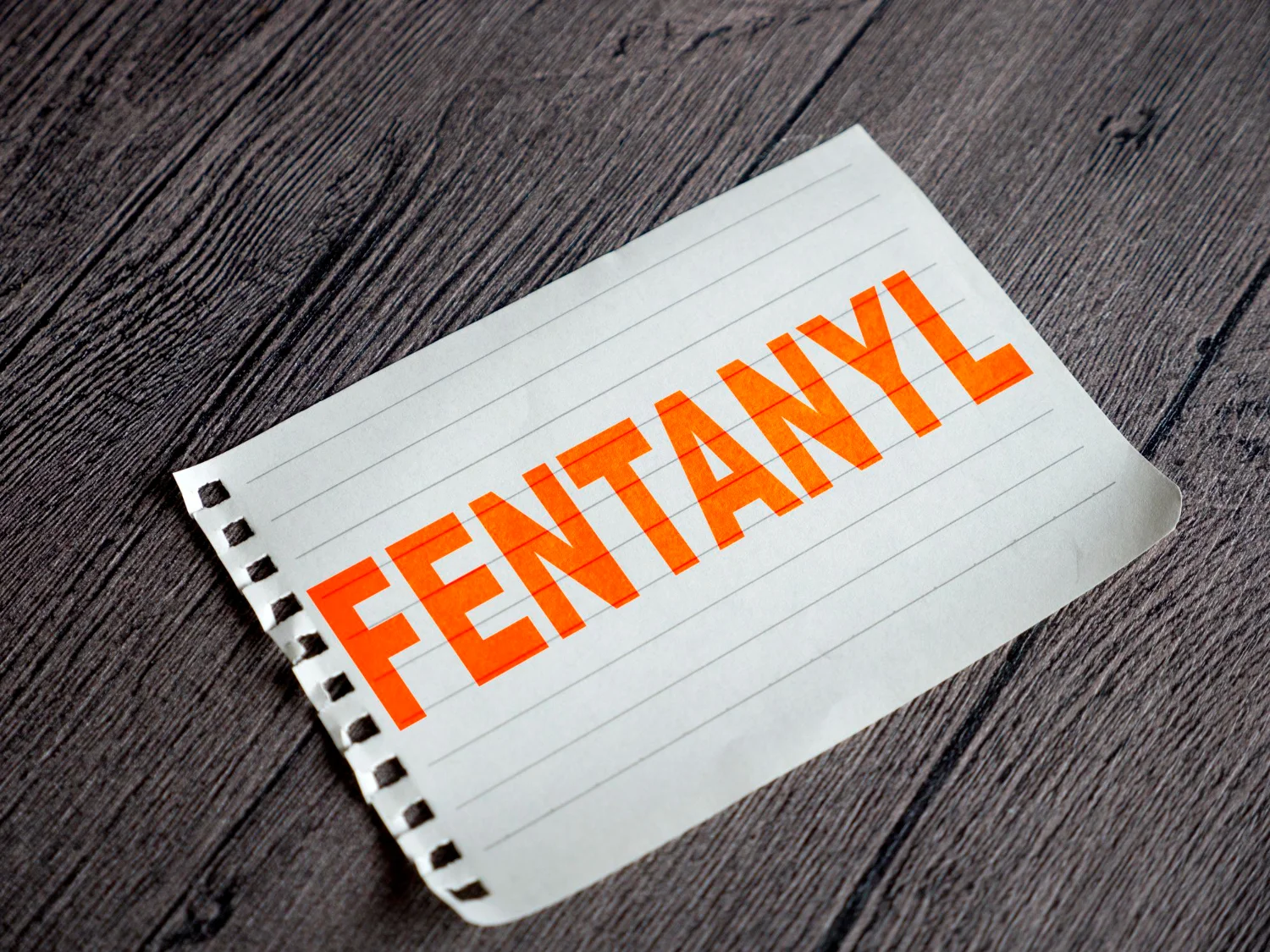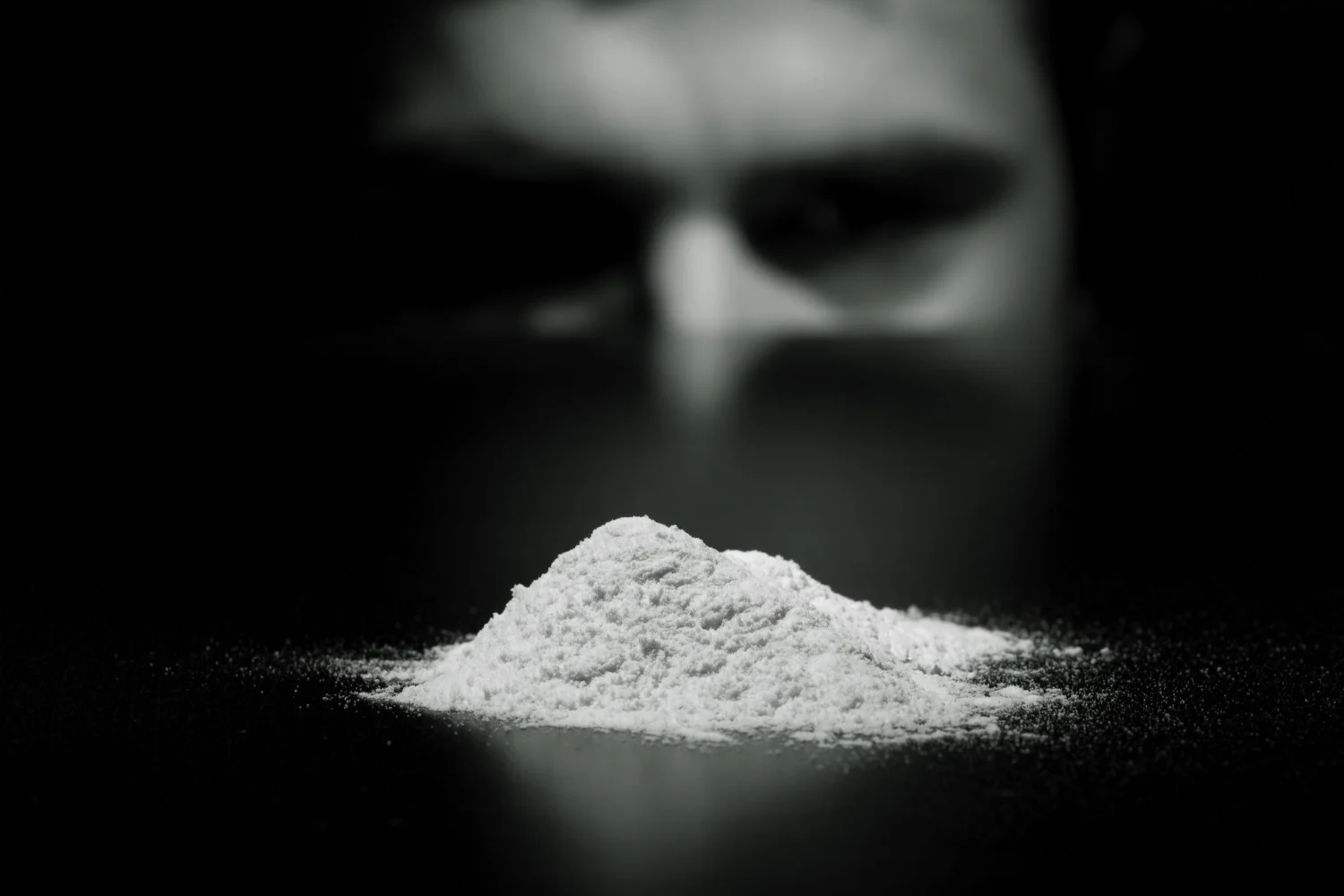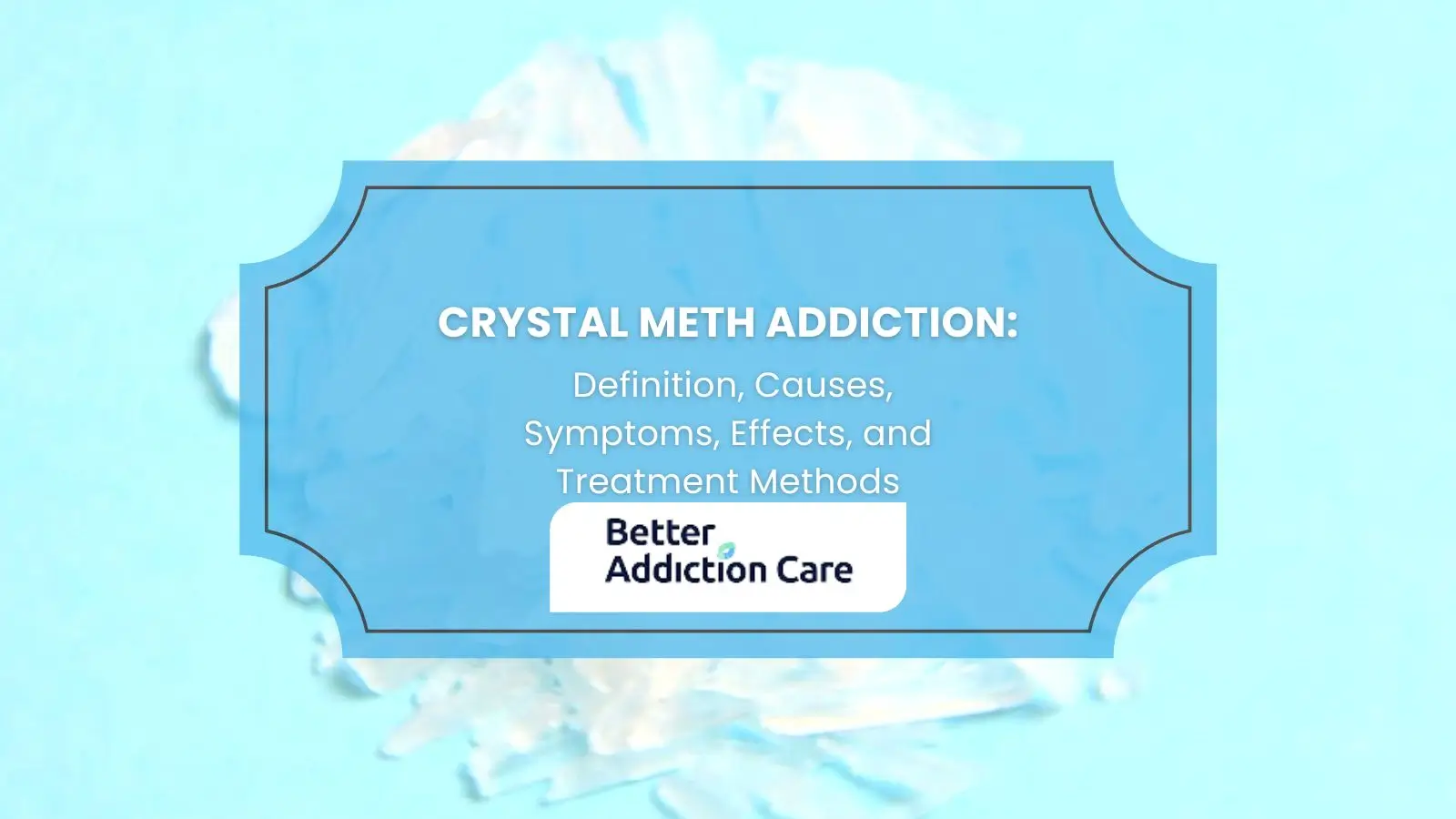Hashish Addiction: Definition, Causes, Symptoms, Effects, and Treatment
`Hashish addiction, known as hash addiction, is the dependence on the cannabis plant i.e. Marijuana. The plant is made by compressing trichomes - the resin-rich glands of cannabis flowers. These tiny trichomes have higher tetrahydrocannabinol (THC) content which produces a stronger psychoactive effect than marijuana.
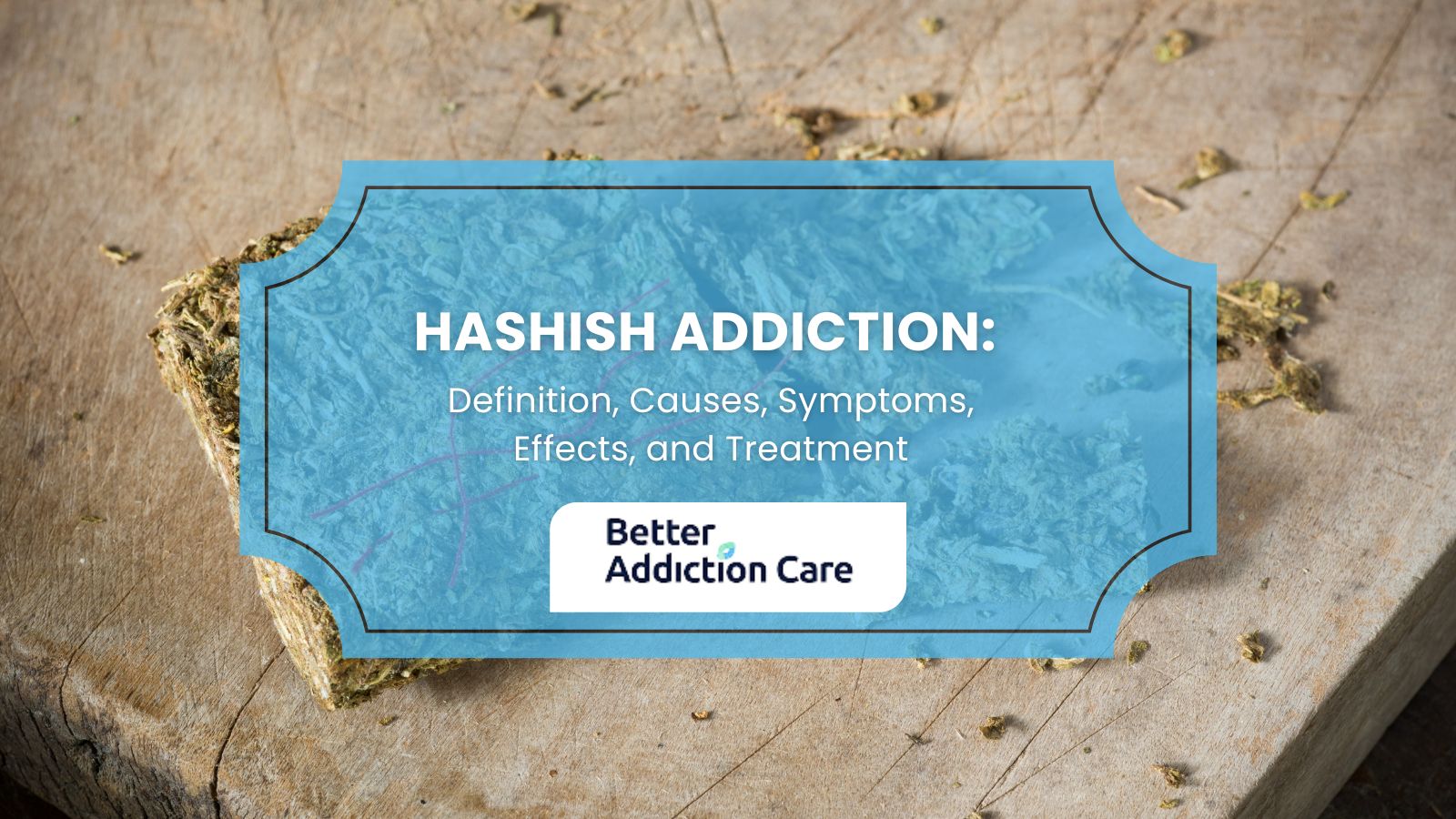
`Hashish addiction, known as hash addiction, is the dependence on the cannabis plant i.e. Marijuana. The plant is made by compressing trichomes - the resin-rich glands of cannabis flowers. These tiny trichomes have higher tetrahydrocannabinol (THC) content which produces a stronger psychoactive effect than marijuana.
The main causes of hashish are biological factors, i.e. genetics, endocannabinoid system activation, and dopamine release. Psychological factors of this addiction include stress and anxiety relief, regulating mood, and curiosity. Social factors of hashish addiction include peer pressure and cultural norms. Mental health disorders (depression, PTSD, OCD, ADHD, bipolar, and anxiety) lead individuals to use hashish as a coping mechanism for their symptoms. This self-medication often leads to dependency worsening both the addiction and the underlying mental health issues.
The symptoms of hashish addiction include physical symptoms such as eye redness, dry mouth, increased appetite, drowsiness, and nausea. Behavioral symptoms of hashish addiction include insomnia, irritability, craving for hashish, difficulty in concentration, decreased interest in activities, and neglect of responsibilities. Psychological symptoms of this addiction include mood swings, anxiety, and social isolation.
The main effects of hashish addiction are impaired memory, anxiety or paranoia, coordinating issues, cognitive impairment, increased heart rate, weakened immune system, and shortness of breath.
The treatment options for hashish addiction include Cognitive Behavioral Therapy (CBT), Motivational Enhancement Therapy (MET), Medications, inpatient and outpatient rehabilitation programs, and support groups.
What is Hash?
Hash is a concentrated cannabis product made from the plant's resinous trichomes. Hash has rich cannabinol, especially tetrahydrocannabinol (THC), as compared to other cannabis flowers which increases its potency.
The minimal consumption of hash drugs resulted in respiratory issues, according to the study titled “Psychiatric effects of hashish” by Tennant & Groesbeck published in the Journal of Archives of General Psychiatry in 1972, whose excessive consumption leads to behavioral and cognitive impairments, such as apathy, lethargy, and memory problems. High hash abuse and simultaneous use of alcohol or other drugs increase psychosis, schizophrenic reactions, and panic attacks.
Increased consumption of hashish leads to clinical impairment and distress, according to the study titled “Cannabis Use Disorder”. The use of hash drugs results in emotional suffering and reduces daily life functioning over time.
How is Hash Consumed?
Hash is consumed in five ways, including smoking, dabbing, vaporizing, eating, and drinking. Smoking includes burning hash in pipes, joints, or even hookahs. Dabbing includes vaporizing hash extract using a dab rig. Vaporizing typically uses vape pens or vaporizers and heats hash to release vapor without burning. Eating includes adding hash to food, such as cooking or baking. Hash is infused into liquids like tea, coffee, smoothies, or cocktails.
How is Hashish Made?
Hashish is made through dry sifting which involves collecting resins from cannabis plants by pressing or hand-rubbing on a sieve or mesh screen. Once the sticky resin is collected it is formed into small balls. Hashish is usually pressed using manual or mechanical presses.
The modern production of hashish involves advanced techniques for extraction. Cannabis plants are initially harvested and dried like traditional methods such as ice water separation, commonly referred to as bubble hash. In this process, the plant buds are submerged in ice water and then filtered out. The solvent extraction methods such as Carbon dioxide and Butane Hash Oil (BHO) involve using pressurized CO2 or solvents to dissolve cannabinoids from concentrated oil.
Rosin pressing is another process of producing hashish, where heat and pressure are applied to collect resin from cannabis without using solvents. The collected resin is then purified and often involves winterization to remove wax and fats. The refined hashish is then easily formulated into bricks, oils, or slabs.
What are the Types of Hashish?
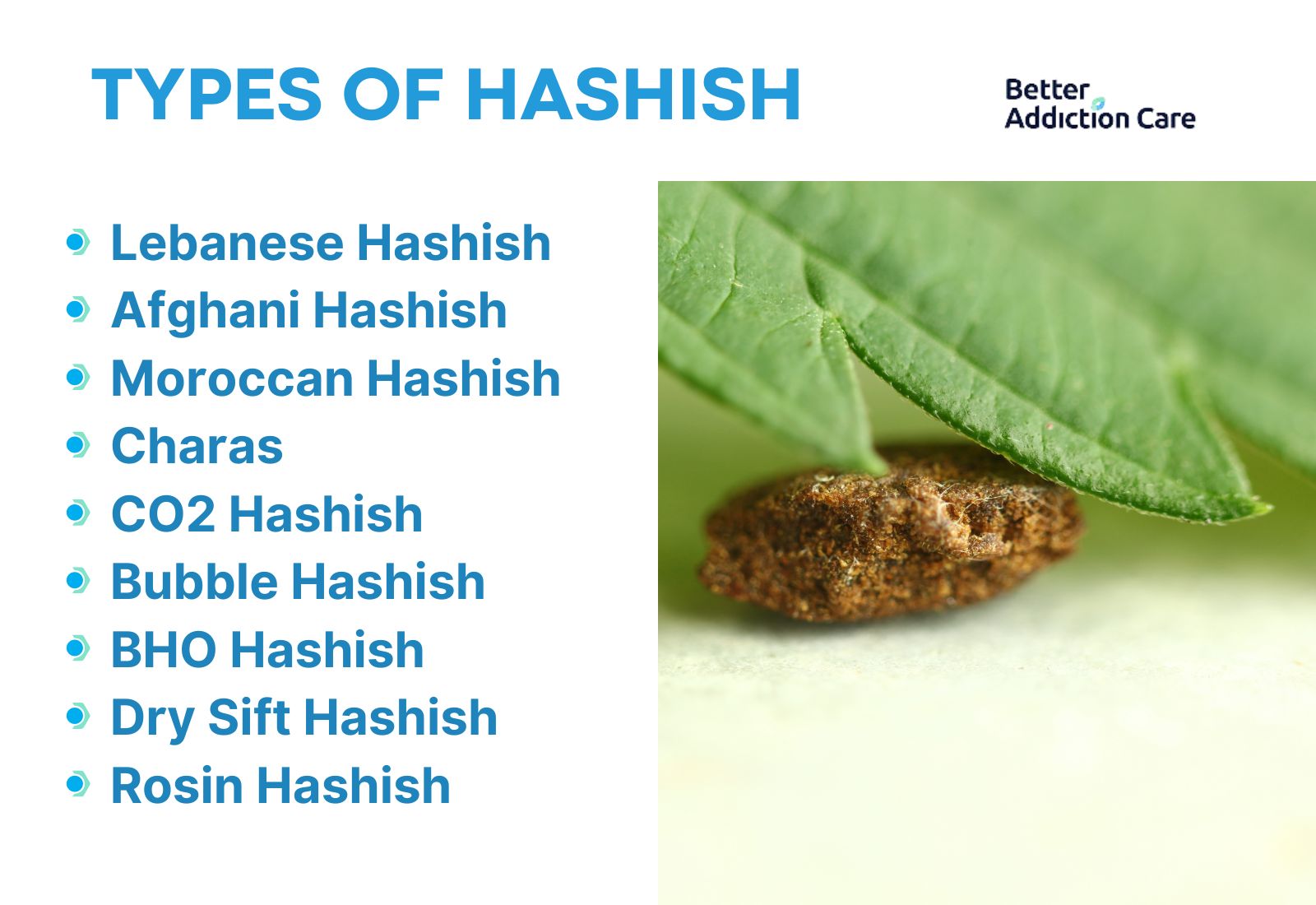
The various types of hashish are Lebanese hashish, afghani hashish, Moroccan hashish, charas, CO2 hashish, bubble hashish, BHO, dry sift hashish and rosin hashish.
These nine types are described below:
-
Lebanese Hashish: Lebanese hashish is usually made by drying and sifting the cannabis plant. Once they are dried the trichomes are extracted and then compressed into slabs. Lebanese hashish comes in both yellow and red varieties. The yellow delivers an energetic feeling, while the red hashish gives relaxation. This type of hashish is known for its earthy flavor and smooth texture. Labon and Morocco have been the largest countries of hashish production for decades, according to the study titled: “Hashish in Morocco and Lebanon: A comparative study” by Kenza Afshani and Salem Darwich published in the Faculty of Agronomy, The Lebanese University, Beirut, Lebanon.
-
Afghani Hashish: Afghani hashish is made from the cannabis plant region of Afghanistan. Afghani hashish is a traditional type of hashish and is made by hand-pressing. The collected trichomes from dried buds produce kief and it is then pressed and baked over a low heat. The dough-like mixture is kneaded until it turns into thickness. This hashish is known for its harsh and spicy flavor.
-
Moroccan Hashish: Moroccan hashish, usually referred to as Moroc, or Kif, has been produced in the Rif mountains of Morocco for centuries. Moroccan hash is made by beating cannabis to extract THC trichomes. After collecting trichomes these are rolled into small blocks and balls. Moroccan hashish has two types including brick hash which is hard and the other is soft pollen hash.
-
Charas: Charas is one of the traditional types of hashish, which is made by directly rubbing the buds with your hands. Charas is commonly used in Asia, especially in Pakistan, India, and Nepal. The produced product is sticky and dark. This is consumed by smoking and is known for its strong psychoactive effects.
-
CO2 Hashish: CO2 hash, typically known as CO2 oil, is a type of cannabis concentration. CO2 hash is produced using supercritical carbon dioxide to collect cannabinoids and terpenes. The cannabis buds are placed in a vessel and pressurized until they become fluid. This is a clean and safe hash used in edibles. It is also used in vape cartridges.
-
Bubble Hashish: Bubble hashish, commonly known as ice water hash is made using ice-water extraction. The frozen cannabis buds are placed in water to gently separate the trichomes. These trichomes are then collected and dried using a freeze-dryer. It has a crystalline structure, with high THC content. There are two types of bubble hash i.e. full melt and full spectrum bubble hash.
-
BHO Hashish: Butane hash oil (BHO) hashish is a cannabis concentrate made using butane extraction. BHO has an oily, thick consistency and a high volume of THC. BHO hashish comes in a variety of textures including budder, crumble, wax, and oil. Hash oil’s production method involves dissolving cannabinoids and then filtering the solution. It is consumed by vaping, dabbing, and adding to edibles.
-
Dry Sift Hashish: Dry sift hashish also referred to as dry sieve, is made by shaking or rubbing cannabis buds over mesh screens. The process begins with separating the trichomes from the plant material. The extracted kief is filtered and pressed and doesn't require heat or solvents during the extraction process.
-
Rosin Hashish: Rosin hashish is a cannabis extract made through heating kief. Heating kief extracts sticky resinous material which is high in cannabinoids and terpenes. Rosin hashish, made without chemicals, is commonly used in dab rigs, vape pens, or added to joints.
How Common is Hashish Addiction?
Hashish addiction is common among youth and young adults as 18% of the US students in 8, 10, and 12 grades consumed hashish once in 2023, according to a report published by Preeti Vankar in 2024, youth aged 12-17, about 6.5% of around 44,000 youth and 34.6% adults aged 18-25, about 302,000 adults from 2017-2019 reported using hashish in the past month of November, as per SAMHSA. Behavioral Health Barometer: Volume 6 as measured through the 2019 National Survey on Drug Use and Health and the National Survey of Substance Abuse Treatment Services.
What are the causes of Hashish Addiction?

The causes of hashish addiction include biological factors, psychological factors, social factors, and co-occurring mental health disorders.
Each cause is described in detail below.
-
Biological factors: Biological factors are strongly linked to the use of hashish. Genetic factors are one of the major causes that make individuals more prone to hashish addiction. Individuals with a family history of hash abuse are more likely to adopt similar habits. Genetics influence individuals at various phases of cannabis use as per the publication titled "The genetic epidemiology of cannabis use, abuse and dependence” published in Addiction in 2006.
-
Psychological factors: Psychological factors influence an individual to consume hashish as a way to deal with negative emotions, curiosity, and relief from stress and anxiety. Some with low self-esteem are more likely to use hash to regulate their mood. Individuals consume cannabis to cope with stress, especially those individuals who are experiencing life traumas and events, according to a study titled “Stress-related factors in cannabis use and misuse: implications for prevention and treatment”. Chronic users rely more on cannabis for stress relief as compared to occasional users.
-
Social Factors: Social factors affect an individual's likelihood of becoming addicted to hashish to fit with social groups or friends. The social norms increase hash abuse for example, individuals living in a society where hashish is legal or accepted can increase its consumption. The parents' negative attitude encourages the use of hashish. The parent’s poverty and illiteracy are the major factors encouraging hashish use, according to the article titled “Hashish Addiction at Higher Education Institutions: Factors and Remedies” published in the European Online Journal of Natural and Social Sciences. The study found that the parents and senior students both contribute to the adoption of hashish use.
-
Co-occurring Mental Health Disorders. Co-occurring Mental Health Disorders are the presence of both substance use disorder (SUDs) and mental illness. People with mental health disorders such as depression, Post-traumatic stress disorder (PTSD), Obsessive-compulsive disorder, attention-deficit hyperactivity disorder (ADHD), bipolar and anxiety disorder may turn to hash. They consume hash drugs for self-medication to reduce their symptoms. Individuals use psychoactive substances like alcohol, marijuana, and other drugs as a strategy to reduce emotional distress, according to a study “Exploring the link between substance use and mental health status: what can we learn from the self-medication theory?” published in the Journal of Health Care for the Poor and Underserved.
What are the Symptoms of Hashish Addiction?

The symptoms of hashish addiction include a combination of physical, behavioral, and psychological signs.
The signs and symptoms are listed below.
Physical symptoms of hashish addiction
The physical symptoms of hashish addiction are eye redness, dry mouth, increased appetite, drowsiness, and nausea.
These symptoms of hashish addiction are discussed below:
-
Eye Redness: Eye redness is a common symptom of hash addiction as the psychoactive compounds dilate the blood vessels and increase the flow of blood which turns the eyes into a reddish color.
-
Dry Mouth: Mouth dryness, or xerostomia occurs when the THC compounds decrease salivary production and cause mouth dryness. Dry mouth has a significant impact on oral health and increases the risk of gum diseases, cavities, and other issues.
-
Increased Appetite: Hashish use often increases appetite, usually called " the munchies". The THC compounds frequently trigger brains and increase the desire for food. This increase in appetite leads to unhealthy eating habits.
-
Drowsiness: Drowsiness is the most common symptom of hashish use as the high doses of THC affect the brain's sleep-wake cycle and lead to tiredness, lack of concentration, impaired coordination, and feelings of sleepiness.
-
Nausea: Nausea is usually experienced by individuals who consume hashish in the form of edibles. The THC disrupts the digestive system and leads to vomiting and stomach discomfort.
Behavioral symptoms of hashish addiction
The behavioral symptoms of hashish addiction are insomnia, craving for hashish, difficulty in concentration, decreased interest in activities, and neglecting responsibilities.
These behavioral symptoms of hashish addiction are elaborated below:
-
Insomnia: The use of hashish greatly impacts the individual's sleep patterns and leads to insomnia. The use of hash drugs creates drowsiness but its regular use can exacerbate sleep difficulties. There is a strong association between the use of cannabis and sleep complaints such as insomnia among university students, according to the study by Coelho titled “Study of the association between cannabis use and sleep disturbances in a large sample of University students”.
-
Craving for Hashish: Craving is a symptom of tolerance and dependence that occurs through the regular use of hashish, making the body addicted to the substance, and increasing intense carvings.
-
Difficulty in Concentration: Difficulty in concentration occurs when the high content of tetrahydrocannabinol impacts the brain areas and decreases focus and cognitive processing.
-
Decreased Interest in Activities: Hashish use reduces an individual's interest in daily activities like school, work, and socializing, as the strong psychoactive component disrupts dopamine.
-
Neglect of Responsibilities: Negligence of responsibilities occurs when the effect of hash drugs reduces an individual's motivation. They start avoiding tasks and ignoring personal and professional responsibilities.
Psychological symptoms of hashish addiction
The psychological symptoms of hashish addiction are mood swings, anxiety, and social isolation.
The psychological symptoms of hashish addiction are described below:
-
Mood Swings: Mood swings among hashish users lead to unpredictable emotions, and they feel relaxed at one time and frustrated at the next. This usually occurs due to THC effects on the brain's ability to maintain moods.
-
Anxiety: The strong effect of THC over stimulates the brain and leads to anxiety, paranoia, nervousness, or even panic attacks.
-
Social Isolation: Hashish use results in social isolation as users gradually withdraw from family and friends. The drug's effects make it feel disconnected, and burdensome, and impair communication. The individual isolates themselves to avoid conflicts as their behaviors become problematic.
What are the effects of Hashish Addiction?
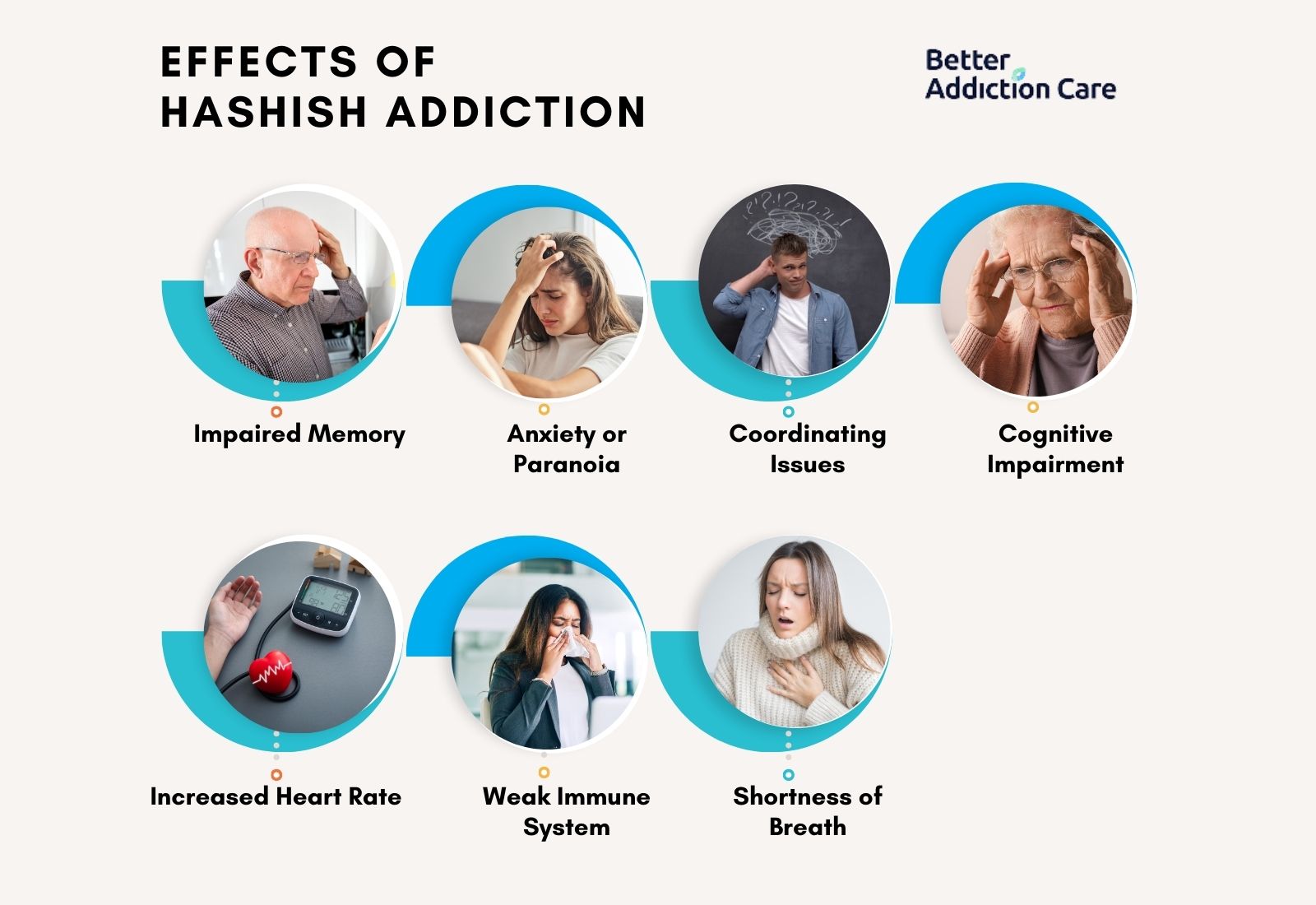
The effects of hashish addiction include impaired memory, anxiety or paranoia, coordinating issues, cognitive impairment, increased heart rate, fatigue, weakened immune system, and shortness of breath.
Each of these effects is explained below:
-
Impaired Memory: Hash drug contains a high volume of THC (tetrahydrocannabinol), which creates strong psychoactive effects. THC interacts with the individual’s brain system and damages its functioning. As a result, it impairs memory function and individuals struggle to retain information. The use of cannabis affects both physical and mental functioning, according to the National Institute on Drug Abuse (NIDA). Cannabis increases irritability and makes individuals feel restless.
-
Anxiety or Paranoia: The THC content in hash releases dopamine, which creates euphoria and results in high anxiety levels in some people. This might result in excessive worrying, fears, racing thoughts, or thinking that others are judging them. Anxiety reactions are the common effect of cannabis use, according to the study by Tunving titled, “Psychiatric effects of cannabis use Acta Psychiatrica Scandinavica”. The consumption of cannabis leads to excessive worry, fear, and flashbacks which trigger anxiety.
-
Coordinating Issues: Hash abuse leads to coordinating issues which are important for individuals to perform tasks. The THC found in hash affects the brain areas that are responsible for coordination. Individuals experience difficulty with balance, clumsiness, and other issues due to it.
-
Cognitive Impairment: The consumption of hashish increases the chance of cognitive function impairment and users experience difficulty in thinking, reasoning, solving complex problems, or focusing. The ingredients in hashish weaken executive functions and decrease daily life performance and productivity.
-
Increased Heart Rate: Hashish influences the cardiovascular system and increases the heart rate due to the high psychoactive compound, THC. These tetrahydrocannabinol cause vessels to enlarge which in turn lowers the blood pressure. The heart pumps more blood and increases the heart rate in response, according to the study “Smoking cannabis is associated with increased risk of heart attack, stroke” published by NIH.
-
Weak Immune System: Hashish affects the individual's immune system by reducing the activity of the immune cells and making the body more prone to infections. The long-term consumption of cannabis reduces the antibodies and disturbs the immune system, according to the study “The Link between Cannabis Use, Immune System, and Viral Infections” by NIH. Hashish use causes breathing issues, impairs the immune system, and increases the risk of viral infections, such as Hepatitis C (HCV) and HIV.
-
Shortness of Breath: The high consumption of hashish causes shortness of breath as it affects the lungs and leads to wheezing and coughing. The lungs reduce their functioning and make breathing difficult over time.
Who is at Risk of Developing Hashish Addiction?
Teenagers, young adults, and individuals with pre-existing mental health conditions are at higher risk of developing a hashish addiction. Regular use, especially starting at a younger age, increases the likelihood of dependency. This is because the adolescent brain is more vulnerable to the effects of hashish leading to long-term cognitive impairments and increased addiction.
Approximately 9-17% of regular hashish users become addicted with a greater risk for those who start during adolescence, according to the study titled “Adverse Health Effects of Marijuana Use” by the National Institutes of Health (NIH). Regular heavy use of hashish can lead to cognitive impairment and increase addiction in adulthood.
What are the Treatment Options for Hashish Addiction?
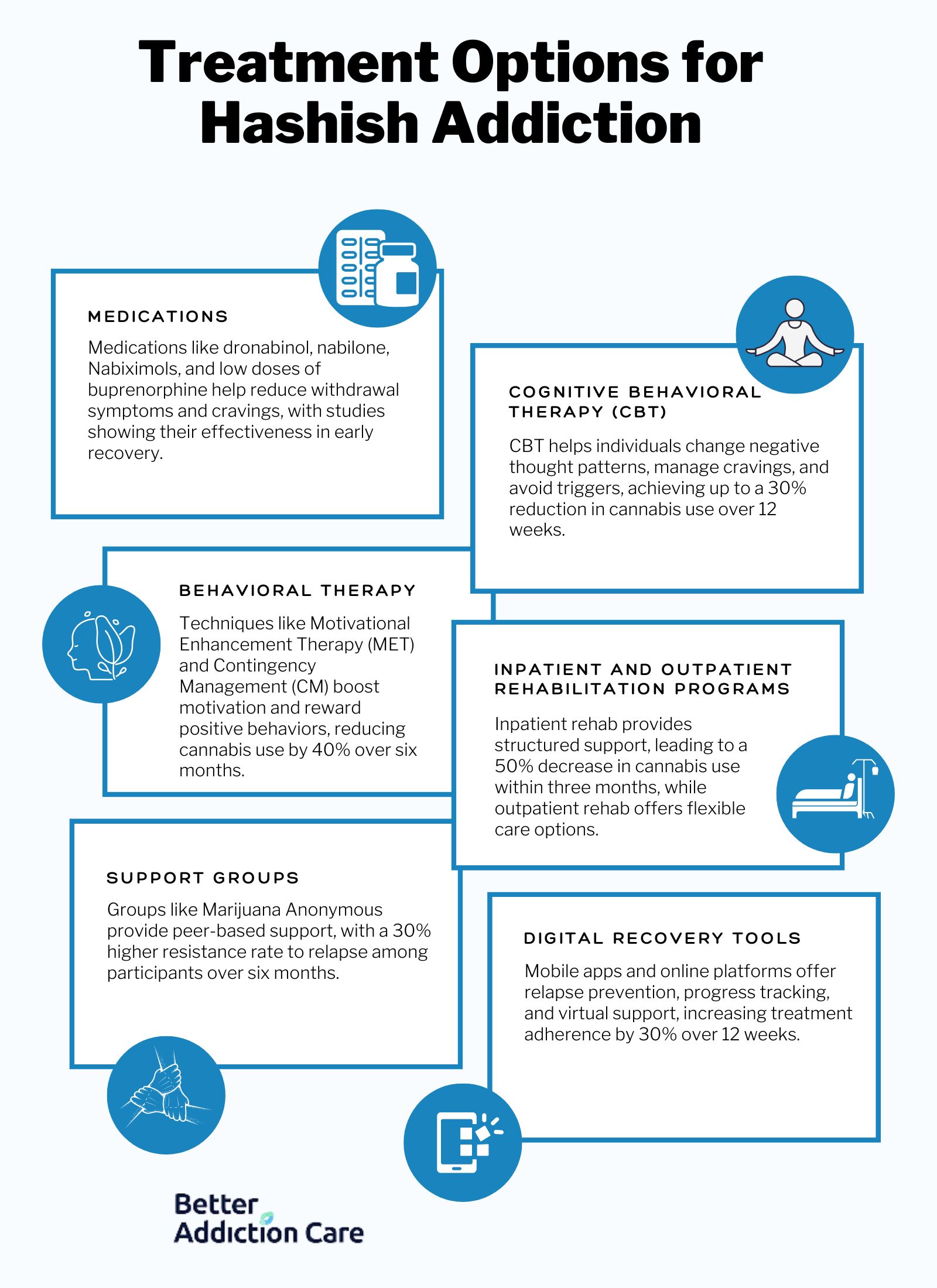
The treatment options for hashish addiction include medications, cognitive behavioral therapy (CBT), behavioral therapy, inpatient and outpatient rehabilitation programs, support groups, and digital recovery tools.
These treatment options are elaborated below:
-
Medications: Medications like dronabinol, nabilone, and Nabiximols are proven effective in reducing hashish withdrawal symptoms, cravings, and relapse risk during early recovery, according to the study on “Systematic Study of Cannabinoids Effects” by M. Werneck in 2018. These medications are well-tolerated with few side effects. Low doses of buprenorphine (4 mg/day) were found to reduce severe hashish cravings, offering a promising treatment option for managing withdrawal, as per the study by J. Ahmadi (2016).
-
Cognitive Behavioral Therapy (CBT): Cognitive Behavioral Therapy is a treatment approach that focuses on changing harmful thought patterns and behaviors. CBT helps individuals develop coping strategies to manage cravings and avoid triggers. CBT reduced cannabis use by 30% after 12 weeks of therapy, according to a study by Budney titled “ Clinical trial of abstinence-based vouchers and cognitive-behavioral therapy for cannabis dependence”. CBT lasts 12-16 weeks with the advantage of promoting long-term behavioral change.
-
Behavioral Therapy: Behavioral therapies such as Motivational Enhancement Therapy (MET) and Contingency Management (CM) are often combined for hashish addiction treatment. Behavioral therapies enhance motivation, shift negative thought patterns, and reward positive behaviors. A combination of these therapies resulted in a 40% reduction in cannabis use over six months, as per research titled “Psychological Interventions for Cannabis Use among Adolescents and Young Adults: A Systematic Review” published by NIH.
-
Inpatient and Outpatient Rehabilitation Programs: Inpatient and outpatient rehabilitation programs provide structured environments for treating hashish addiction. Inpatient programs offer support and supervision promoting immediate recovery. Individuals in inpatient care reported a 50% reduction in cannabis use after three months as per the study titled, “Substance Abuse and Mental Health Services Administration, 2020”. Outpatient programs provide flexibility in staying at home while maintaining accountability.
-
Support Groups: Support groups, such as Marijuana Anonymous provide peer-based support for individuals recovering from hashish addiction. These groups create a sense of community, accountability, and shared experiences. Participation in support groups led to a 30% higher resistance rate after six months compared to those who did not attend, according to the study “Comparative Effectiveness of Postdischarge Smoking Cessation Interventions for Hospital Patients” published by NIH.
-
Digital Recovery Tools: Digital recovery tools, such as mobile apps and online platforms help in managing hashish addiction by offering features like relapse prevention strategies, progress tracking, and virtual support groups. Tools like the ReSET-O app increased treatment adherence and abstinence rates by 30% over 12 weeks, according to a study titled “The Rise of Prescription Digital Therapeutics in Behavioral Health” by NIH.
What are the Withdrawal Symptoms of Hashish Addiction?
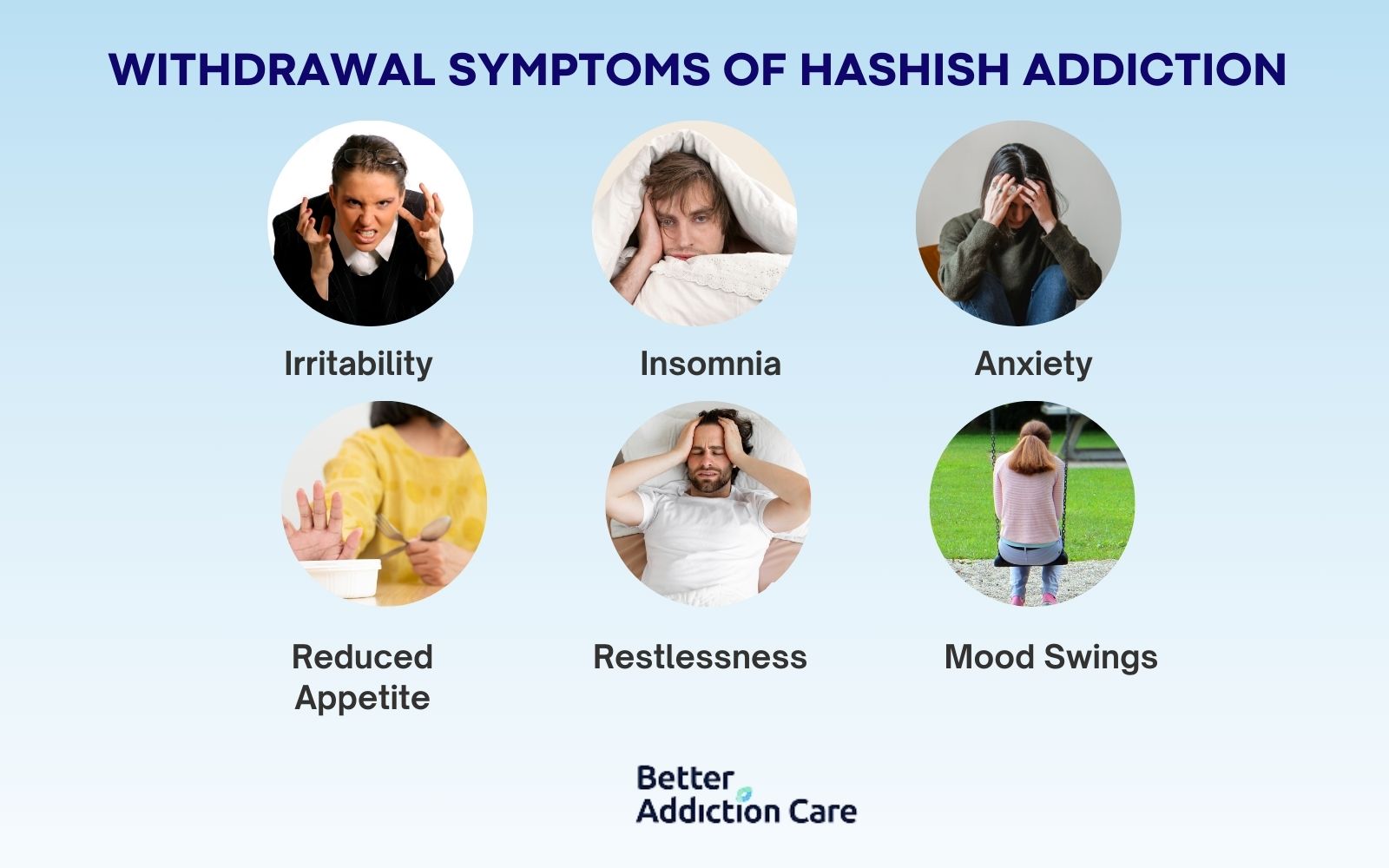
The withdrawal symptoms of hashish addiction are irritability, anxiety, insomnia, decreased appetite, restlessness, and mood swings. Hashish withdrawal symptoms refer to a series of physical and psychological symptoms that occur when a person who has been regularly using hashish reduces or stops use. These symptoms usually begin within 24-48 hours after stopping the use and it lasts for up to two weeks or longer. Nearly 50% of regular hashish users experience clinical withdrawal symptoms which shows the need for proper management during recovery, according to a study by KH Levin in NCBI (2010).
The common hashish withdrawal symptoms are listed below.
-
Irritability: Irritability occurs when individuals become easily frustrated or angry during hashish withdrawal. Irritability is due to the brain's adjustment to reduced THC levels. It peaks within the first week of withdrawal, according to the NIH. Managing it involves relaxation techniques like deep breathing and mindfulness practices.
-
Insomnia: Insomnia refers to difficulty falling or staying asleep as the body struggles to adjust without the sedative effects of hashish. 46% of cannabis users experience insomnia during withdrawal, as per the study titled “Prevalence of Cannabis Withdrawal Symptoms Among People With Regular or Dependent Use of Cannabinoids” by NIH. Sleep hygiene practices like a regular bedtime routine and avoiding caffeine help manage this symptom.
-
Anxiety: Anxiety is the excessive worry or unease during hashish withdrawal. Reduced cannabis intake disrupts the body's stress regulation. It is common during early withdrawal. Cognitive-behavioral strategies and physical exercise are effective ways to reduce anxiety symptoms.
-
Reduced Appetite: Loss of appetite occurs because THC stimulates appetite, and its absence leads to reduced hunger. This symptom typically subsides within a few days eating small, nutrient-dense meals and avoiding heavy foods can help maintain proper nutrition.
-
Restlessness: Restlessness is the feeling of being unable to relax or stay still. Restlessness increases the body’s need to readjust without hashish. Managing it through physical activity such as walking or stretching helps release unused energy.
-
Mood Swings: Mood swings are rapid changes in emotional states as the brain’s neurotransmitter levels fluctuate without THC. These are prevalent in the first week of withdrawal from hashish, according to the study titled “The cannabis withdrawal syndrome: current insight” by NIH.
How to Prevent Hashish Addiction?
To prevent hashish addiction, educate individuals about the risks of hashish use, indulge in healthier activities, and create a support network. Early education reduces the chances of starting to use substances like hashish, according to the research titled “The Effectiveness of an Empowerment Education Intervention for Substance Use Reduction among Inner-City Adolescents in Nigeria” published by NIH.
Many individuals use hashish to cope with stress, anxiety, or depression. Addressing these issues through therapy or counseling helps individuals to find healthier ways to manage their feelings. Activities such as exercise, art, or mindfulness practices reduce stress. Creating a strong support network allows individuals to resist peer pressure to use hashish. Encouraging friendships that focus on positive activities leads to better choices and a lower risk of addiction to hashish.
How Does Hashish Addiction Relate to Other Substance Addictions?
Hashish addiction relates to other substance addictions like alcohol and opioid addictions by affecting the brain's reward system and causing similar withdrawal symptoms like irritability and anxiety. Early hashish use can increase the risk of harder drug experimentation, such as cocaine or methamphetamine. Co-occurring mental health issues such as anxiety and depression often complicate hashish addiction.
What is the difference between hashish and marijuana addiction?
The difference between hashish and marijuana addiction is that both are products of the cannabis plant. Marijuana refers to the dried flowers and leaves, which contain varying levels of THC. Hashish is a concentrated form of cannabis made from the resin of the plant, resulting in a higher THC content.
Hashish and marijuana both lead to addiction and exhibit similar withdrawal symptoms, such as anxiety and cravings. Marijuana addiction is typically less potent. Hashish increases the risk of addiction and intensity of withdrawal symptoms compared to marijuana.
What is the difference between hashish and tobacco addiction?
The difference between hashish and tobacco addiction is that both substances lead to addiction but differ in their composition and effects. Hashish is derived from the cannabis plant's resin and contains high levels of THC, the psychoactive compound that alters mood and perception. Tobacco comes from the leaves of the Nicotiana plant and primarily contains nicotine, a stimulant that increases heart rate and creates dependency.
Hashish and tobacco both lead to symptoms like cravings and irritability. Hashish is primarily used for its psychoactive effects. Tobacco is often used for its stimulating properties. The health risks associated with tobacco addiction, such as lung cancer and heart disease are more severe compared to the risks of hashish, which includes cognitive impairment and respiratory issues from smoking.
What is the difference between hashish and heroin addiction?
The difference between hashish and heroin addiction is that hashish is a concentrated form of cannabis made from the resin of the cannabis plant, containing high levels of THC, which produces psychoactive effects. Heroin is an opioid derived from morphine known for its powerful euphoric effects and high potential for addiction.
Hashish and heroin both lead to symptoms such as cravings and anxiety, but heroin addiction has a higher risk of overdose and more severe health consequences. Hashish is more associated with mental health effects.


